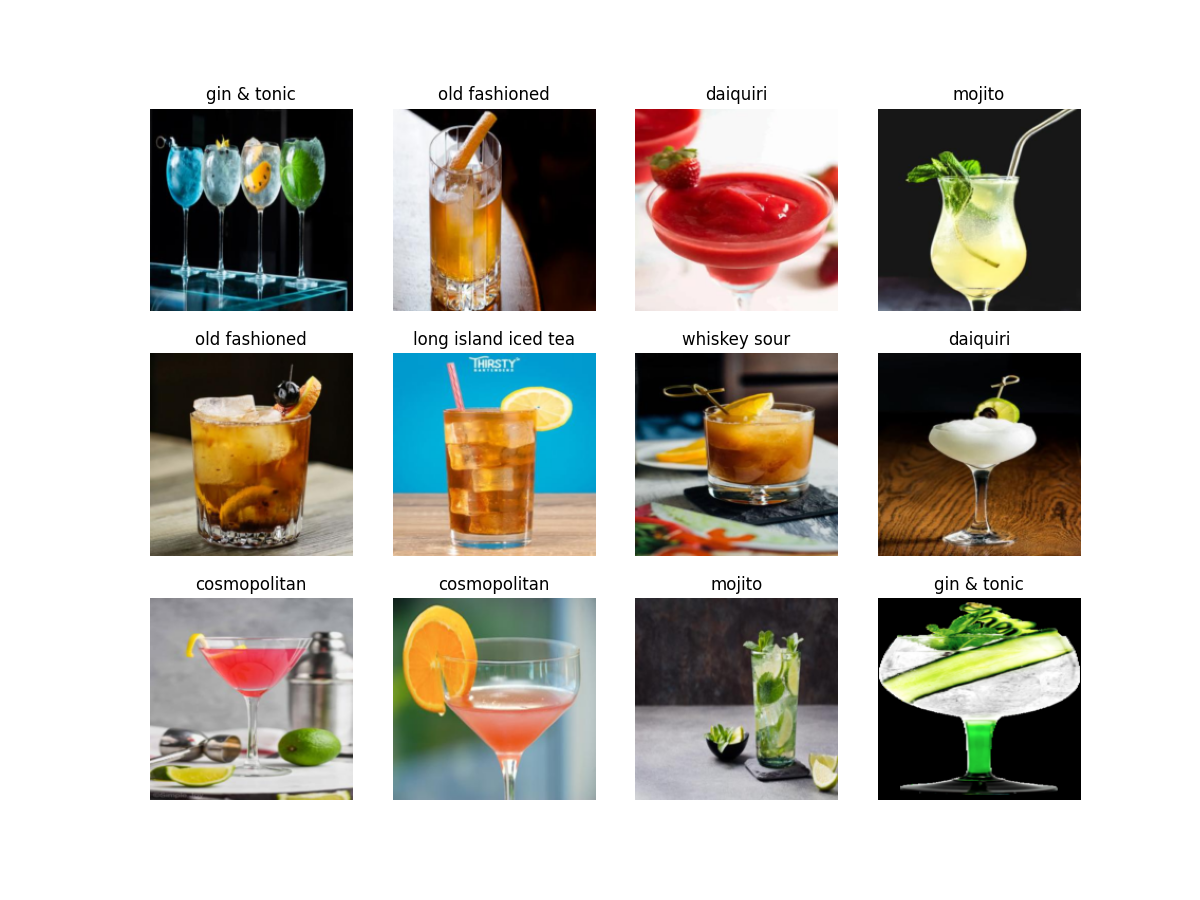I recently started a new course called Practical Deep Learning. The course is taught by Jeremy Howard, a machine learning legend and founder of fast.ai. One of the first lessons in the course was training a classifier to detect birds in images. As part of learning the materials, I thought i’d be a fun experiment to extend this model to classify the top 10 most popular cocktails. Let’s get started 🍸🍹.
What we’re building
The goal is to identify the most popular cocktails in images. We’ll be focusing on the below 10 cocktails:
- Old Fashioned
- Margarita
- Mojito
- Piña Colada
- Manhattan
- Whiskey Sour
- Gin & Tonic
- Long Island Iced Tea
- Cosmopolitan
- Daiquiri
In order to accomplish this goal, we’ll be fine tuning a ResNet18 model on images collected via the DuckDuckGo search engine. From there, we’ll feed the model our images to see how it performs.
Installing our Dependencies
Before we get started let’s pip install our Python packages from fast.ai and DuckDuckGo.
pip install -U fastai duckduckgo_search
Now that we have our packages installed, let’s collect our data.
Retrieving the Data
In order to train the model, we need some images of cocktails. Luckily, DuckDuckGo provides a nice way to do this.
We’ll use a Python package called duckduckgo_search to accomplish fetching some images for training.
Let’s define a function that takes a search term and max_images and returns a list of image URLs for download:
from duckduckgo_search import DDGS
from fastcore.all import L
def search_images(term, max_images=200):
return L(DDGS().images(term, max_results=max_images)).itemgot('image')
print(search_images("margarita", max_images=1))
Running this script returns an image of a margarita.
Let’s now collect 100 images of each drink type for training.
We’ll also cleverly create drink directories so that we can use the parent directory name for training later.
The last thing we’ll do is use the fastai verify_images function to remove any images that weren’t
downloaded correctly:
from fastcore.all import *
from time import sleep
drinks = "old fashioned", "margarita",
"mojito", "pina colada",
"manhattan", "whiskey sour",
"gin & tonic", "long island iced tea",
"cosmopolitan", "daiquiri"
path = Path('drinks')
# Loop over drinks and download 100 images.
for o in drinks:
dest = (path/o)
dest.mkdir(exist_ok=True, parents=True)
download_images(dest, urls=search_images(f'{o} drink photo', max_images=100))
sleep(5)
resize_images(path/o, max_size=400, dest=path/o)
# Remove any failed downloads.
failed = verify_images(get_image_files(path))
failed.map(Path.unlink)
print(len(failed))
Awesome, at this point we’ve got an organized file structure of our drink data. Let’s take a peek:
drinks
daiquiri
4790c0ff-e523-4e20-8168-6daff1dba026.jpg
8fd1dd30-aca2-452b-a8c1-5c7fe48ee46a.jpg
old fashioned
303b9759-e221-4880-974e-bf80f8930514.jpg
b00c262d-d6da-452e-9e9a-0ed6bd616ee4.jpg
cosmopolitan
35171536-c66d-4d51-8a0c-91f553517095.jpg
29cdb5d0-3305-4798-b2b0-3523989defe2.jpg
whiskey sour
2459b494-f28a-4cae-9d91-d47e654f2d43.jpg
eae1d636-7f22-4a7b-8d0b-b3e8a5543b19.jpg
long island iced tea
a4c36272-f6da-4156-8243-e45fefb3a93e.jpg
58816b29-fa35-4c05-ba04-19ab8c218710.jpg
manhattan
4a455be1-df81-40b1-becb-aa0819531316.jpg
05a71cdc-126c-4587-982a-98dc23117f7a.jpg
mojito
dbd52674-f6c1-4efc-8d17-afc42fd4b799.jpg
34420fb7-2e4f-42d6-9c0b-51c6299b6561.jpg
gin & tonic
0e62862b-de77-4ba6-b425-0491cafc342a.jpg
88859bb4-f704-425c-bc00-5b3d82d8e5d5.jpg
margarita
8595af09-f927-4381-813a-4b1c6b204c70.png
85997818-a971-43a5-a240-f38ae73ae9e7.jpg
pina colada
e85622b3-7ea8-44ce-8d4e-17571e2e85e7.jpg
9fcfc108-40d2-4247-a48e-f00c43614a91.jpg
Training the Model
Now that we’ve got our images installed, let’s get on with training our model.
We’ll use the fastai DataBlock object to create a slice of training and validation images:
from fastai.vision.all import *
from matplotlib import pyplot
path="drinks"
dls = DataBlock(
blocks=(ImageBlock, CategoryBlock),
get_items=get_image_files,
splitter=RandomSplitter(valid_pct=0.2, seed=42),
get_y=parent_label,
item_tfms=[Resize(192, method='squish')]
).dataloaders(path)
dls.show_batch(max_n=12)
pyplot.show() # Note, this is only needed if running outside of a notebook.
Some important items to call out here are that we’re using the ImageBlock and CategoryBlock to align
our images with the parent_label of the directory. In other words, we are aligning the drink picture with
the correct drink type. Let’s take a look at a few images in our training set.

Pretty cool! Now, let’s get to training! We’ll use a vision_learner to fine tune a ResNet18 model on 20 epochs of the data.
It’s interesting to see the train_loss decrease showing that our model is learning from the data. We’ll save our model weights after training.
learn = vision_learner(dls, resnet18, metrics=error_rate)
learn.fine_tune(20)
learn.save("model-weights.pth")
Downloading: "https://download.pytorch.org/models/resnet18-f37072fd.pth" to /Users/nickherrig/.cache/torch/hub/checkpoints/resnet18-f37072fd.pth
100%|█████████████████████████████████████████████████████████████████████| 44.7M/44.7M [00:03<00:00, 12.9MB/s]
epoch train_loss valid_loss error_rate time
0 3.096997 1.252397 0.422460 00:08
epoch train_loss valid_loss error_rate time
0 1.606826 0.992143 0.320856 00:04
1 1.433372 0.864932 0.283422 00:02
2 1.200389 0.742975 0.235294 00:02
3 0.977225 0.647414 0.197861 00:02
4 0.781976 0.621067 0.203209 00:02
5 0.609433 0.641216 0.181818 00:02
6 0.482900 0.673247 0.197861 00:02
7 0.388355 0.690616 0.197861 00:02
8 0.310900 0.725696 0.181818 00:02
9 0.249916 0.718665 0.171123 00:02
10 0.201577 0.729631 0.160428 00:02
11 0.166233 0.751359 0.187166 00:02
12 0.134805 0.753634 0.181818 00:02
13 0.110021 0.742285 0.176471 00:02
14 0.090679 0.746338 0.181818 00:02
15 0.075912 0.746500 0.176471 00:02
16 0.063471 0.742904 0.171123 00:02
17 0.054150 0.740524 0.165775 00:02
18 0.045349 0.742151 0.165775 00:02
19 0.038965 0.745595 0.176471 00:02
Run the Model
Let’s test our model out! Remember that margarita we grabbed before? Well it wasn’t in our training set so let’s see how our model does!
from fastai.vision.all import *
# Load the model weights.
learn = load_learner("model_weights.pth")
# Classify the image.
drink, test, probs = learn.predict(PILImage.create('test-drink.webp'))
# Print the results.
print("the image is a", drink)
print("All Drink Probabilities", probs)
the image is a margarita
All Drink Probabilities tensor([2.1035e-08, 1.2926e-07, 8.4791e-08, 8.0075e-12, 3.1995e-11, 1.0000e+00,
1.3793e-06, 1.8493e-08, 3.7605e-07, 1.3780e-06])
I’d be lying if I told you I’m a fastai expert. What I will tell you, though, is that being able to train this model in a couple of seconds and having a usable drink classifier for an application is pretty incredible.
Software is eating the world, ladies and gents, and models are eating software.
Looking forward to blogging more about these concepts and my learning while continuing this class.
Cheers 🥂